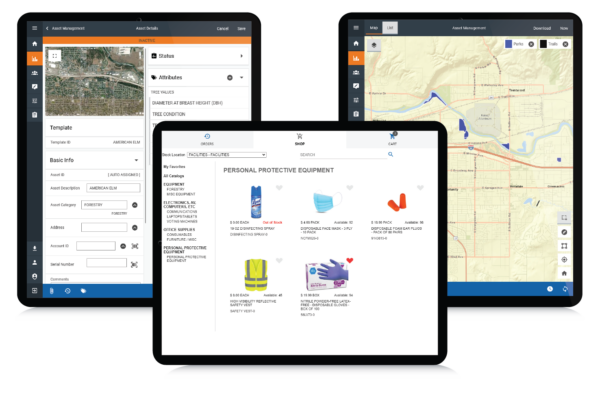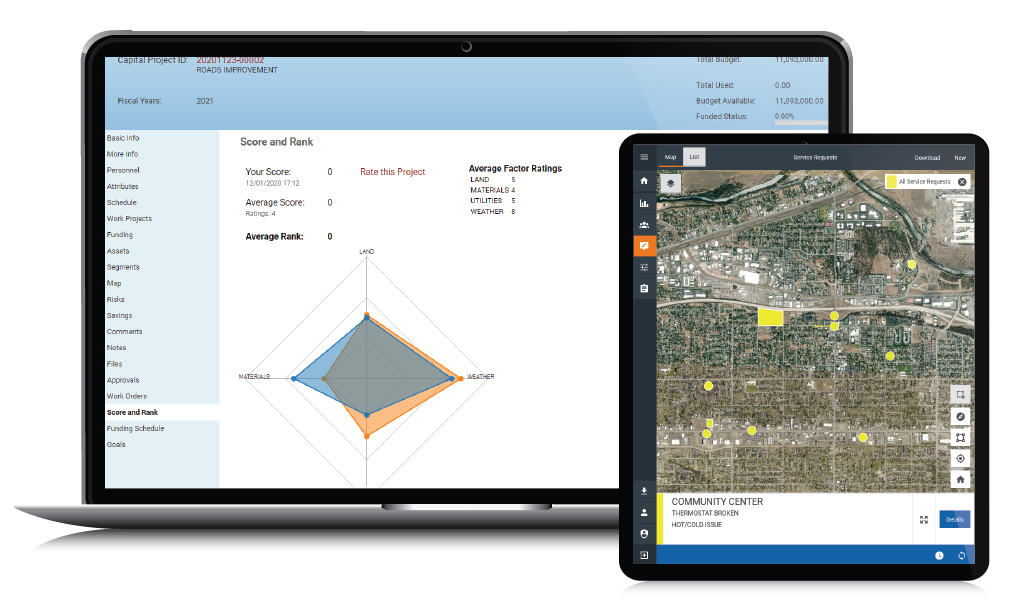Enterprise Asset Management (EAM) software is a comprehensive solution that enables organizations to manage, track, and optimize their assets throughout their entire lifecycle. Asset management includes everything from acquisition and installation to maintenance, repair, and disposal. With improper asset management, enterprises may struggle with inefficiencies, downtime, and unnecessary costs, making EAM software an essential tool for maintaining a competitive edge.
An EAM solution provides a centralized platform for monitoring assets to streamline processes. Asset management systems ensure equipment is maintained, minimizing the risk of unexpected breakdowns that could disrupt operations and result in financial losses. By proactively scheduling maintenance and leveraging predictive analytics, an asset management system empowers enterprises to identify potential issues before they escalate.
Benefits of Real-time Asset Tracking
Optimized Asset Utilization
An EAM solution optimizes asset utilization by centralizing asset information necessary for decision-making. The asset management system offers a comprehensive database detailing asset specification, maintenance history, and performance metrics. By tracking real-time data and trends, organizations can ensure assets get effectively utilized, operational efficiency is maximized, and overall productivity is improved.
Reduced Downtime
Enterprise asset management software minimizes downtime through proactive maintenance. The EAM solution analyzes historical and real-time data to predict potential maintenance issues, allowing enterprises to schedule preventive maintenance before problems escalate. The asset management systems also streamline work order management to ensure maintenance needs are timely responded to, optimizing maintenance practices, and reducing unplanned downtime.
Improved Maintenance Strategies
EAM solutions also act as a maintenance management system by providing real-time visibility into asset performance and condition, allowing enterprises to schedule maintenance. The maintenance management system centralizes data so enterprises can make informed decisions through predictive analytics and historical performance trends- increasing operational efficiency and asset lifespan.
Enhanced Compliance
EAM solutions help maintain a comprehensive record of asset maintenance, inspections, and compliance activities. The asset management system ensures organizations maintain accurate record-keeping and documentation of asset-related activities. Remaining in compliance reduces the potential for fines or penalties and enhances an organization’s reputation for responsible and accountable practices.
Data-Driven Insights
Asset management reporting and analytics track key performance indicators (KPIs) and metrics required to gain data-driven insights, including:
- Asset utilization to optimize resource allocation
- Maintenance costs to efficiently manage budgets
- Downtime/uptime to enhance operational efficiency
These indicators help in decision-making by providing visibility into asset performance, predicting maintenance needs, and ensuring compliance to improve asset efficiency, reduce downtime, and improve the allocation of assets.
Streamlined Workflows
Enterprise Asset Management software automates tasks, such as maintenance scheduling, work orders, and inventory management. The asset management system allows for communication and data to occur in one integrated system for more efficient operations. Real-time tracking ensures tasks get completed promptly- optimizing processes and resources for enhanced productivity.
Improved Financial Planning
An EAM solution improves financial planning by providing enterprises insight into asset deprecation, maintenance costs, and lifecycle projections. The asset management system enables enterprises to allocate budgets more effectively and forecast expenses accurately. Analyzing historical data and performance metrics with an asset management system allows for informed financial decisions to ensure long-term fiscal stability.
Accurate Asset Data
An EAM solution ensures enterprises have accurate asset data through its real-time updates and eliminating manual data entry. The system uses Geographic Information Systems (GIS) to ensure precise asset data is collected by visually mapping assets’ locations. These integrative solutions enable spatial tracking, allowing for accurate asset identification, tracking, and maintenance planning.

Features
Enterprise Asset Management software automates data collection, data analytics, and physical assets. Employing an EAM solution not only enhances existing operations, but it allows enterprises to gain valuable insight into the inner workings of how their business is operating:
Lifecycle Management
An asset management system manages the maintenance of physical assets throughout an asset’s lifecycle, which consists of six stages:
- Planning- Time spent researching possible new assets that best fit your needs.
- Acquisition– When the asset is purchased.
- Utilization- Time spent training users on how to operate the asset safely and efficiently.
- Maintenance- From the beginning to the end of life, an asset will undergo maintenance.
- Disposal- When the long-term value of the asset no longer justifies the cost of maintaining it.
Enterprise Asset Management systems will continuously track assets to extend their life cycles. Asset lifecycle management with EAM provides an overview of performance, maintenance requirements, and specific business indicators. Completing asset lifecycle management will improve sustainability by maintaining assets and extending their lifecycle.
Work Order Management
In Enterprise Asset Management software, work orders are tracked spatially via the map, list views, or both. Work orders get generated on one or multiple assets with unlimited tasks, services, and inspections. Work orders can be auto-assigned based on the type of work and area of responsibility, saving time for staff by removing the need for manual work scheduling.
Asset Performance Management
EAM solutions continuously monitor and enhance asset performance. By centralizing data and analytics, asset management systems empower enterprises to optimize the efficiency and effectiveness of their assets. The performance of assets directly impacts overall success, as efficient and well-maintained assets contribute to streamlined operations, reduced downtime, and higher productivity. Poor asset performance can lead to operational disruptions, decreased output, and potential revenue loss.
Capital Planning
Using an asset management system for capital planning, municipalities, counties, states, and public works organizations can consider all areas where projects might need extra funding. Capital planning allows organizations to anticipate future challenges, so projects get completed on time and under budget.
GIS Asset Management
Geographic Information System (GIS) in asset management software integrates spatial data, enabling organizations to visualize, analyze, and manage assets with their physical locations. GIS asset management enhances decision-making by providing a geographic context and facilitating efficient asset tracking, maintenance scheduling, and resource allocation. GIS-equipped asset management software improves spatial awareness, optimizing operations and supporting data-driven strategies for effective asset utilization and maintenance.
Asset Risk Management
EAM software assists in identifying and mitigating asset-related risks by aggregating and analyzing data on asset condition, performance, and maintenance history. Asset risk management enables proactive risk assessment, helping organizations anticipate potential failures, safety concerns, or compliance issues. Insight into asset vulnerabilities allows EAM solutions to mitigate risk and ensure operational continuity.

Leveraging Mobile Asset Management
Mobile asset management solutions revolutionize remote management by providing organizations with the tools to manage their assets from anywhere, even in remote areas. The mobile solutions enable fleet technicians, supervisors, and managers to access critical asset data, work orders, and maintenance records on smartphones and tablets. This real-time connectivity and data accessibility offer several benefits, including streamlined communication, quick decision-making, improved efficiency, and enhanced asset performance.
With mobile asset management, field technicians can receive work orders, update asset information, and report maintenance activities from the field to reduce manual paperwork and data entry. Having mobile asset management allows managers to gain real-time insight into asset conditions and performance in real-time, enabling them to make informed decisions promptly. When there is a potential issue, mobile asset management solutions allow teams to respond swiftly- minimizing downtime and preventing costly breakdowns.
Mobile asset management promotes collaboration among remote teams, allowing for efficient allocation of resources, optimal scheduling, and the timely completion of tasks. Remaining constantly connected will also enhance compliance by providing easy access to historical maintenance records and documentation to ensure they adhere to industry standards.
Implementing EAM Software for Operational Efficiency
EAM implementation involves several key steps, from initial planning to execution:
- Define Objective Goals
Outline objectives wanting to achieve with the asset management solution - Assess Current Processes
Evaluate existing asset management practices to identify pain points, inefficiencies, and areas of improvement. - Gather Requirements
Ask maintenance teams, IT, and management to gather requirements for the EAM solution. - Vendor Selection
Research and select a suitable EAM solution vendor that aligns with requirements. - Plan Implementation
Create a detailed implementation plan outlining tasks, timelines, responsibilities, and sources required for each phase of the project - User Training
Provide comprehensive training to users on how to use the EAM solution effectively. - Pilot Testing
Conduct a pilot test with a small group of users to validate system functionality - Full Rollout
Roll out the EAM solution to all relevant teams and departments.
A successful EAM implementation involves selecting the right EAM solution that aligns with your organizational goals to optimize your asset management processes.
Select the Right Enterprise Asset Management Solution
AssetWorks Enterprise Asset Management (EAM) software offers a comprehensive solution for organizations seeking to optimize their asset lifecycle management. Features like maintenance scheduling, asset tracking, and predictive analytics empower businesses to enhance operational efficiency and reduce downtime. The software’s user-friendly interface ensures easy adoption and seamless integration into existing workflows, promoting swift implementation and staff productivity. “AssetWorks EAM looked like it was the most manageable and the easiest to use from both an end-users and a system administrator’s perspective, said Seattle Parks and Recreation Asset Management and Work Order Project Manager Pam Bank in a case study about AssetWorks EAM. By choosing AssetWorks EAM software, organizations can effectively manage their assets, streamline maintenance processes, and ultimately drive cost savings while maximizing the lifespan of their valuable resources.

Conclusion
EAM solutions optimize operational efficiency by providing a centralized platform for streamlined asset management, facilitating proactive maintenance scheduling, and enabling data-driven decision-making. By efficiently tracking asset performance, automating maintenance processes, and offering predictive insights, Enterprise Asset Management software empowers organizations to minimize downtime, reduce unplanned disruptions, and allocate resources more effectively- enhancing overall operational productivity and performance.
If you are considering changing your Enterprise Asset Management software, or if you are thinking of adopting Enterprise Asset Management software for the first time, there are some questions you will want to consider, including:
- Are there compliance and regulatory requirements on assets you must adhere to?
- Is your current asset maintenance leading to frequent breakdowns, downtime, or unexpected costs?
- Are you experiencing challenges in tracking and managing assets?
- Are you concerned about maintaining a competitive edge in your industry?
- Are you interested in gaining deeper insights into asset performance?
- Are you looking to optimize your asset lifecycle management?
If you answered “yes” to any of the above questions, it is worth exploring a new Enterprise Asset Management system.












